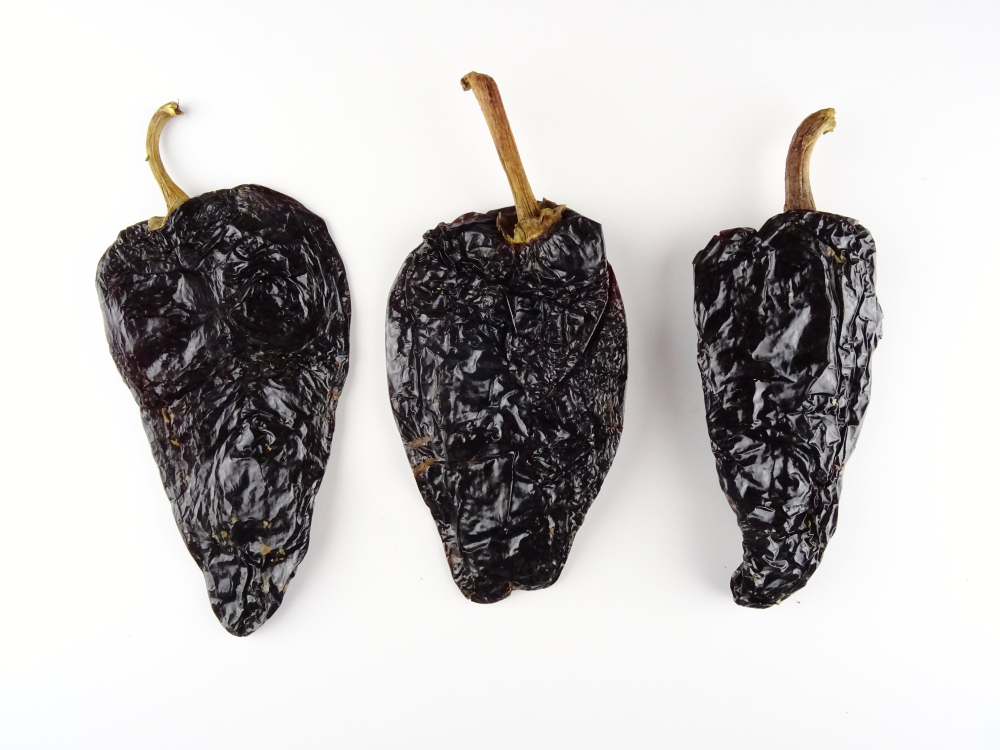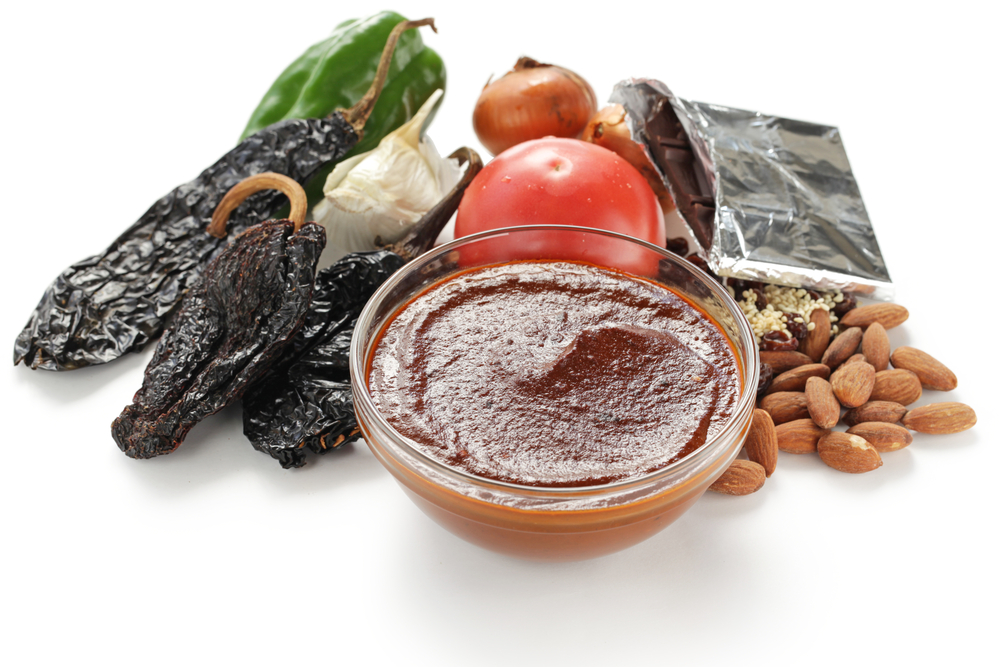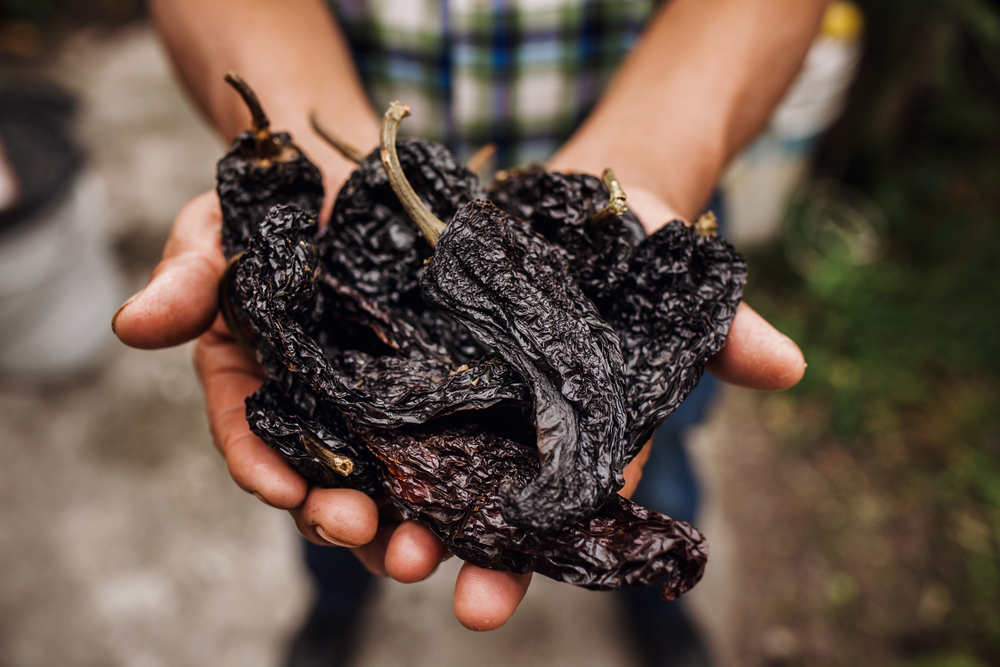Ancho chiles are dried poblano peppers. When dried, ancho chiles have a mild spice level with a sweet, earthy, almost chocolatey flavor. They're typically ground and used in spice mixes, sauces, soups, and marinades.
What Is An Ancho Chile?
Also called chile ancho, ancho pepper, or ancho chili, ancho chile is the dried version of poblano peppers.
Ancho chiles originate from the state of Puebla in Mexico and are widely used complementarily in Mexican food as part of the ‘holy trinity’ that includes Mulato and Pasilla chiles. Ancho peppers are also commonly used in the southwestern U.S.
When harvested right before ripening, poblano peppers still have a green color. This is how they’re typically sold and used in their fresh form. To make Ancho chile, they are left to turn red after harvesting. This will result in a milder, less spicy chile. Peppers left to ripen to red on the vine will be slightly hotter. Ancho chile powder has a deep red color.
Poblano chiles are large, heart-shaped, flat, and leathery. They have a wrinkled texture when dry. When dry, the chiles should be clean, untorn, unblemished, and pliable.
Poblano chiles are named for their large size, with “ancho” meaning “wide” in Spanish. The peppers usually span 2.5-3.5 inches wide, with a profile that tapers to a point.

Ancho chiles are rich in vitamins A and C for a healthy immune system and reduced inflammation. They also have vitamin K, which helps heal wounds faster, and Vitamin B1, which helps turn carbohydrates into energy.
The dried peppers also contain fiber and traces of iron and niacin (vitamin B3). Depending on the manufacturer, magnesium, potassium, and calcium are also present in processed ancho chiles.
How Hot Are Ancho Chile Peppers?
Ancho chile peppers average between 1,000 and 2,000 Scoville Heat Units (SHU) on the Scoville Scale.
The 1,000-2,000 SHU score range means ancho chiles are mild peppers. They are large peppers, meaning their capsaicin (the main chemical in chili peppers, which belong to the genus Capsicum) content is lower, unlike smaller peppers.
The heat value of ancho chili can vary substantially based on where they grow and the amount of sunlight they receive. Even the same plant could produce peppers with different SHU values!
The hotness of ancho chiles is higher than that of Bell peppers (0 SHU) and slightly higher than Anaheim peppers, which average 500-1,000 SHUs.
Different Varieties Of Ancho Chile Peppers
Poblano peppers give rise to two types of chiles—ancho chile and Mulato chile. Both versions are dried.
The level of maturity influences the difference between the two peppers at harvesting. Although both versions are harvested when fully mature, the ancho chiles are harvested unripened, while the Mulato chiles are harvested fully ripe.
The Mulato chiles are sweeter and hotter than ancho chili, given that they are allowed to grow longer to full ripening. They have a deeper, more chocolatey flavor.
How Are Ancho Chiles Used In Cooking?
Ancho chiles are used ground, pureed, or whole-dried. Ancho chili powder or the ground or powdered form is usually available in shakers in most grocery stores.
You can reconstitute whole-dried ancho chili peppers by soaking them in hot water to soften for 20-30 minutes, with or without the seeds and seed veins. The seeds may make the reconstituted version bitter.
Pureeing the reconstituted ancho chili will enhance its consistency in flavor.
Ancho chiles are usually used in cooking sauces, such as the famous mole sauce and enchilada sauce. Before cooking, you can also use them as a marinade or rub for flavoring seafood, poultry, and meat.

Ancho chiles are mixed with vegetables and other seasonings or spices when used as a base for soups and stews.
You can also use ancho chili as a substitute in meals that require chili powder or paprika. The ancho provides a taste and mild heat similar to or close to paprika and chili powder.
Ancho Chile Substitutes
Depending on your preference, you can use the following as substitutes for ancho chiles:
- Mulato chiles (hotter)
- Guajillo chiles (hotter)
- Pasilla chiles
- Chipotle (for a more smoky flavor)
- New Mexico chili powder (for close mild spiciness)
- Regular chili powder
- Red pepper flakes / crushed red pepper
- Paprika
Where To Buy Ancho Chile Peppers
You can buy ancho chiles peppers from a grocery store or supermarket near you in whole or ground form. You’ll find them in shakers when ground or in bags when sold whole.
Mexican groceries are also an excellent place to buy ancho chili, but only if you are lucky to have one near you.
Ancho chiles are also available from various reputable sources online, such as Amazon and online stores run by dedicated spices companies.
Can You Grow Ancho Chiles?
Poblano peppers are very easy to grow in the home garden
The one thing to note is that, as we mentioned earlier, ancho chiles will have varying SHU values depending on where you grow them and how much sunlight your plants will get.
How To Dry Ancho Chile Peppers
Once your poblano peppers are ripe and have the right color and size, you can harvest them for drying into ancho chile peppers. The peppers should be richly dark green, measuring 4-6 inches in length at harvesting time.
You can dry your harvested peppers overnight in a dehydrator, which is the easiest way. The peppers should be arranged in a single layer. Set your dehydrator to 130 degrees for 12 hours.
It’s important to consider that different peppers will need different total drying times, given that they may have varying moisture content levels at harvest time, even when they are from the same plant.
A second option, if you prefer a natural drying method—drying the peppers delicately in the sun. Be sure to hang the peppers individually in a place with good sunshine and unrestricted airflow.
The sun-drying process is tricky. You must keep checking the drying area’s humidity levels to avoid rotting. Your patience will be tested for the 3-4 weeks it will take to obtain thoroughly dried peppers.

